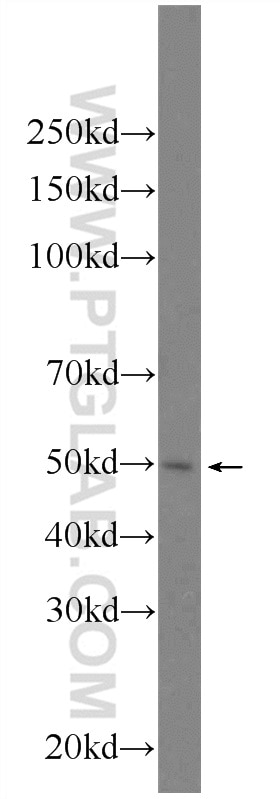FYTTD1 Polyklonaler Antikörper
FYTTD1 Polyklonal Antikörper für WB, ELISA
Wirt / Isotyp
Kaninchen / IgG
Getestete Reaktivität
human
Anwendung
WB, ELISA
Konjugation
Unkonjugiert
Kat-Nr. : 24560-1-AP
Synonyme
Geprüfte Anwendungen
| Erfolgreiche Detektion in WB | HeLa-Zellen |
Empfohlene Verdünnung
| Anwendung | Verdünnung |
|---|---|
| Western Blot (WB) | WB : 1:200-1:1000 |
| It is recommended that this reagent should be titrated in each testing system to obtain optimal results. | |
| Sample-dependent, check data in validation data gallery | |
Produktinformation
24560-1-AP bindet in WB, ELISA FYTTD1 und zeigt Reaktivität mit human
| Getestete Reaktivität | human |
| Wirt / Isotyp | Kaninchen / IgG |
| Klonalität | Polyklonal |
| Typ | Antikörper |
| Immunogen | FYTTD1 fusion protein Ag20051 |
| Vollständiger Name | forty-two-three domain containing 1 |
| Berechnetes Molekulargewicht | 318 aa, 36 kDa |
| Beobachtetes Molekulargewicht | 50 kDa |
| GenBank-Zugangsnummer | BC039734 |
| Gene symbol | FYTTD1 |
| Gene ID (NCBI) | 84248 |
| Konjugation | Unkonjugiert |
| Form | Liquid |
| Reinigungsmethode | Antigen-Affinitätsreinigung |
| Lagerungspuffer | PBS with 0.02% sodium azide and 50% glycerol |
| Lagerungsbedingungen | Bei -20°C lagern. Nach dem Versand ein Jahr lang stabil Aliquotieren ist bei -20oC Lagerung nicht notwendig. 20ul Größen enthalten 0,1% BSA. |
Hintergrundinformationen
FYTTD1 also termed as UAP56 interacting factor or UIF is a 318 amino acid protein, which belongs to the UIF family. FYTTD1 localizes to nucleus and is required for mRNA export from nucleus to cytoplasm. Functioning as an adaptor, FYTTD1 utilizes the BAT1/DDX39-TAP pathway, which is essential for efficient mRNA export and nuclear pore delivery. FYTTD1 interacts with SSRP1, a protein that is necessary for its recruitment of mRNAs, in addition to a mutually exclusive interaction with BAT1/DDX39 and TAP. The molecular weight of post-translation modified FYTTD1 is observed 50 kDa.
Protokolle
| PRODUKTSPEZIFISCHE PROTOKOLLE | |
|---|---|
| WB protocol for FYTTD1 antibody 24560-1-AP | Protokoll herunterladen |
| STANDARD-PROTOKOLLE | |
|---|---|
| Klicken Sie hier, um unsere Standardprotokolle anzuzeigen |


